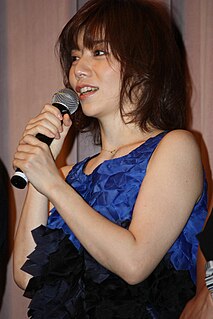Simon Isogai is a Japanese singer and musician from Kanagawa Prefecture, Japan. Formerly signed with Victor Entertainment, he has his own independent label, Hit-o-ride Records.

Tameiki (Sigh) is Jun Shibata's second studio album and best-selling to date. It was released on February 26, 2003 and peaked at No. 12 in Japan.

Hitori (Alone) is Jun Shibata's third studio album. It was released on 25 February 2004 and peaked at No. 15 in Japan.

Shibaura is Jun Shibata's second compilation album. It was released on March 14, 2007, and peaked at No. 36 in Japan.
Sore Demo Kita Michi is Japanese singer Jun Shibata's 2nd single. It was released on February 20, 2002 and peaked at #90.
Kenzo Kitakata is a Japanese novelist, especially known for his hardboiled novels. He studied law at Chuo University in the early 1970s. He served as the 10th President of the Mystery Writers of Japan from 1997 to 2001.
Fumika Shimizu is a Japanese actress, gravure idol and model. In February 2017, she announced her temporary retirement from the entertainment industry to join the controversial Happy Science religion. Through Happy Science, she announced a return to acting under her new name Yoshiko Sengen with Happy Science's ARI Production company.
The Braille pattern dots-123 is a 6-dot braille cell with all three left side dots raised, or an 8-dot braille cell with the top, upper-middle, and lower-middle left dots raised. It is represented by the Unicode code point U+2807, and in Braille ASCII with "L".
The Braille pattern dots-24 is a 6-dot braille cell with the top right and middle left dots raised, or an 8-dot braille cell with the top right and upper-middle dots raised. It is represented by the Unicode code point U+280a, and in Braille ASCII with I.
The Braille pattern dots-125 is a 6-dot braille cell with the top left and both middle dots raised, or an 8-dot braille cell with the top left and both upper-middle dots raised. It is represented by the Unicode code point U+2813, and in Braille ASCII with H.
The Braille pattern dots-45 is a 6-dot braille cell with the top and middle right dots raised, or an 8-dot braille cell with the top and upper middle right dots raised. It is represented by the Unicode code point U+2818, and in Braille ASCII with a caret: ^.
The Braille pattern dots-26 is a 6-dot braille cell with the middle left and bottom right dots raised, or an 8-dot braille cell with the upper-middle left and lower-middle right dots raised. It is represented by the Unicode code point U+2822, and in Braille ASCII with the number 5.
The Braille pattern dots-126 is a 6-dot braille cell with the top and middle left, and bottom right dots raised, or an 8-dot braille cell with the top and upper-middle left, and lower-middle right dots raised. It is represented by the Unicode code point U+2823, and in Braille ASCII with the less than sign: <.
The Braille pattern dots-12346 is a 6-dot braille cell with both top, both bottom, and the middle left dots raised, or an 8-dot braille cell with both top, both lower-middle, and the upper-middle left dots raised. It is represented by the Unicode code point U+282f, and in Braille ASCII with the ampersand: &.
The Braille pattern dots-256 is a 6-dot braille cell with both middle, and the bottom right dots raised, or an 8-dot braille cell with both upper-middle, and the lower-middle right dots raised. It is represented by the Unicode code point U+2832, and in Braille ASCII with the number 4.
The Braille pattern dots-356 is a 6-dot braille cell with the middle right and both bottom dots raised, or an 8-dot braille cell with the upper-middle right and both lower-middle dots raised. It is represented by the Unicode code point U+2834, and in Braille ASCII with the number 0.
The Braille pattern dots-2356 is a 6-dot braille cell with both middle and both bottom dots raised, or an 8-dot braille cell with both upper-middle and both lower-middle dots raised. It is represented by the Unicode code point U+2836, and in Braille ASCII with the number 7.
Yuta Takahata is a Japanese actor and tarento.

"Kaerimichi wa Tōmawari Shitaku Naru" (帰り道は遠回りしたくなる) is the 22nd single by Japanese idol girl group Nogizaka46. It was released on 14 November 2018. It reached number one on the weekly Oricon Singles Chart with 1.063 million copies sold, and also debuted at number one on the Billboard Japan Hot 100. It marks Nanase Nishino's graduation from the group.





